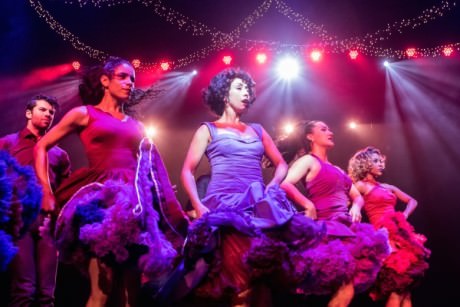Signature Theatre’s production of West Side Story is every bit as eye-filling and ear-thrilling as any lover of this great American musical could wish.
On a spacious thrust stage inside the intimate Max, with the audience seated on three sides, Director Mathew Gardiner and Choreographer Parker Esse have unleashed a dancing-and-singing cast with breathtaking muscular force and vibrant vocals. Seated in full view above the action is a 17-member orchestra, conducted by Jon Kalbfleisch, that becomes a glorious aural wall. Lighting Designer Jayson Lyons has created an immersive visual world so animate it seems alive.

Often it all seems overwhelming, more gorgeous than one can behold at one time. And we are so close we seem inside it.
The only imperfection I can report is that those in speaking roles (Bobby Smith as Doc, John Leslie Wolfe as Lieutenant Schrank, and Russell Sunday as Officer Krupke) deliver acting performances far more persuasive (and more uniformly audible) than those whose singing and dancing shines so stunningly. But that blip by no means diminishes what is a superb experience in musical theater.
Wisely Gardiner has made no attempt to update or darken the material—an approach he took last season with Cabaret with brilliant results. (Recently Molly Smith updated and darkened Oliver at Arena with interesting but mixed results.) How a production’s staging says its when is just as relevant as how it says the show’s what, where, who, how, and why. And in this respect, West Side Story is a curious case.
Though it touches on such timely topics as gang warfare, police malfeasance, ethnic animus, and immigration, the world of West Side Story does not translate to now. It can’t. And the reason is, it was always a fantasy world. The original world of Dickens’Oliver Twist was real. The original world of Christopher Isherwood’s Berlin Stories really happened. By contrast, West Side Story, which premiered in 1957, was imagined by four white men—Arthur Laurents (book), Leonard Bernstein (music), Stephen Sondheim (lyrics), and Jerome Robbins (original direction and choreography)—who, brilliant as they were, had as much first-hand experience of the musical’s inner-city setting as Shakespeare had of fair Verona in 1595.

And yet many an audience member in the orchestra during the original West Side Story Broadway run may have left the theater thinking they had been treated to a peek inside an authentic Manhattan environment where the lives of others not like themselves were rendered with some verisimilitude. They had to have known it was a prettified peek. But from their socioeconomic perch did they notice what a complacency-coddling concoction the entire show actually was? As musical theater it is beautiful beyond measure. I take no issue with Signature’s calling it “America’s greatest musical.” But in its depiction of life in America’s urban underclass, it is pure American BS.
The score is of course peerless. The lyrics glisten. And the show’s dramatic structure is well made as can be.
At the same time the book is laden with lingo said by no street kid ever. There is nary a nod to the story’s economic class context (the Moynihan Report was not to appear till 1965). The most politically pointed it gets is the sendup of profiling and stereotyping in “Gee, Officer Krupke”—a song that provides terrific comic relief in Act Two but that also offers audiences a cheap chance to check the “I really get these people” box.
Here’s a thought experiment to play out my premise a bit further.
There’s a play by Marcus Gardley produced by Mosaic Theater currently running at Atlas called The Gospel of Lovingkindness. It’s inspired by a true story; it’s set in a real place, South Side Chicago; its themes are contemporary and pressing; its characters and conflicts do not seem made up from whole cloth; its powerful poetic language echoes real people’s speech. Under Jennifer L. Nelson’s direction the script of The Gospel of Lovingkindness plays stupendously; it pulses with truth-telling. And if one day it became source material for a chamber musical or opera, it could be amazing.
The fact that theater has increasingly made space on stage for the voices of creators who have actually lived the stories they tell, to whom what happens in their stories has happened, for whom the hope and purpose of their storytelling matters deeply and personally—that fact is slowly but surely changing how we see.

In that respect West Side Story at Signature is wonderfully worth seeing for what it is. And importantly worth seeing for what it isn’t.
Is it possible to admire and enjoy the design and performing talent invested in a musical theater classic without excising one’s conscience and comprehension about how the material is of its time?
I should hope so.
Running Time: About two hours 30 minutes, including one intermission.
West Side Story plays through January 31, 2015 at Signature Theatre – 4200 Campbell Avenue, in Arlington, VA. For tickets, call the box office at (703) 820-9771 or purchase them online.
LINK:
David Siegel’s 5 star review of West Side Story on DCMetroTheaterArts.




